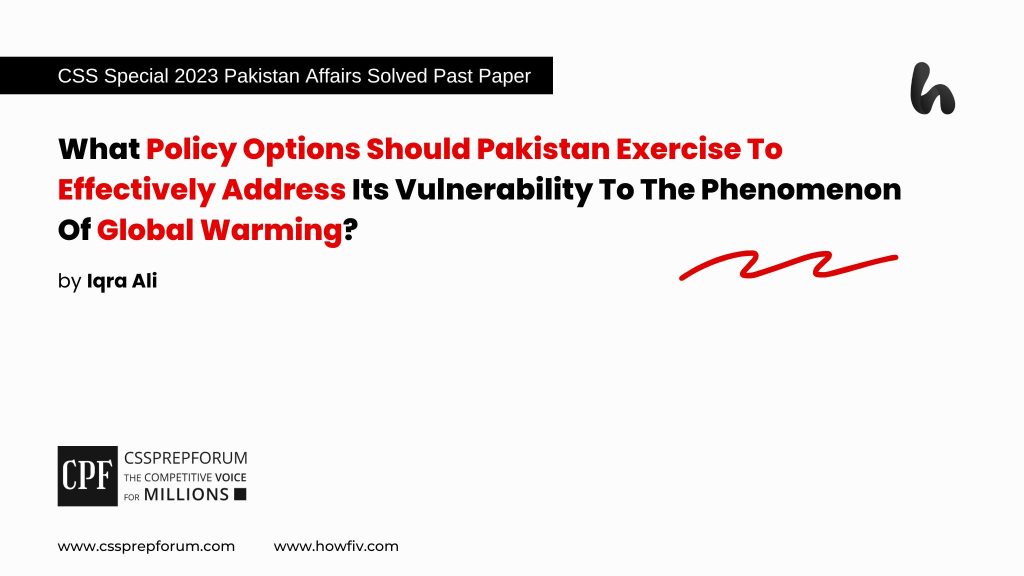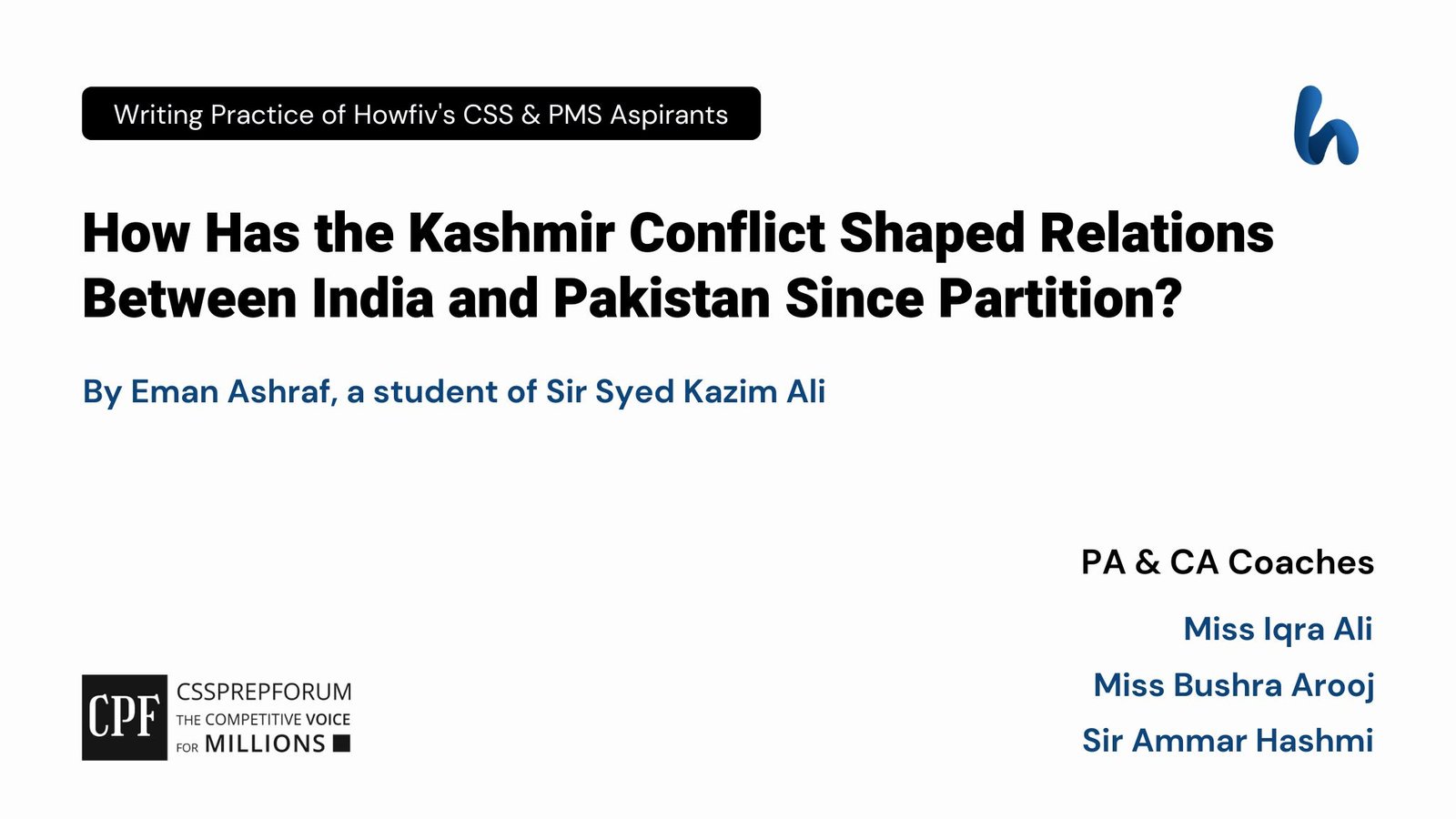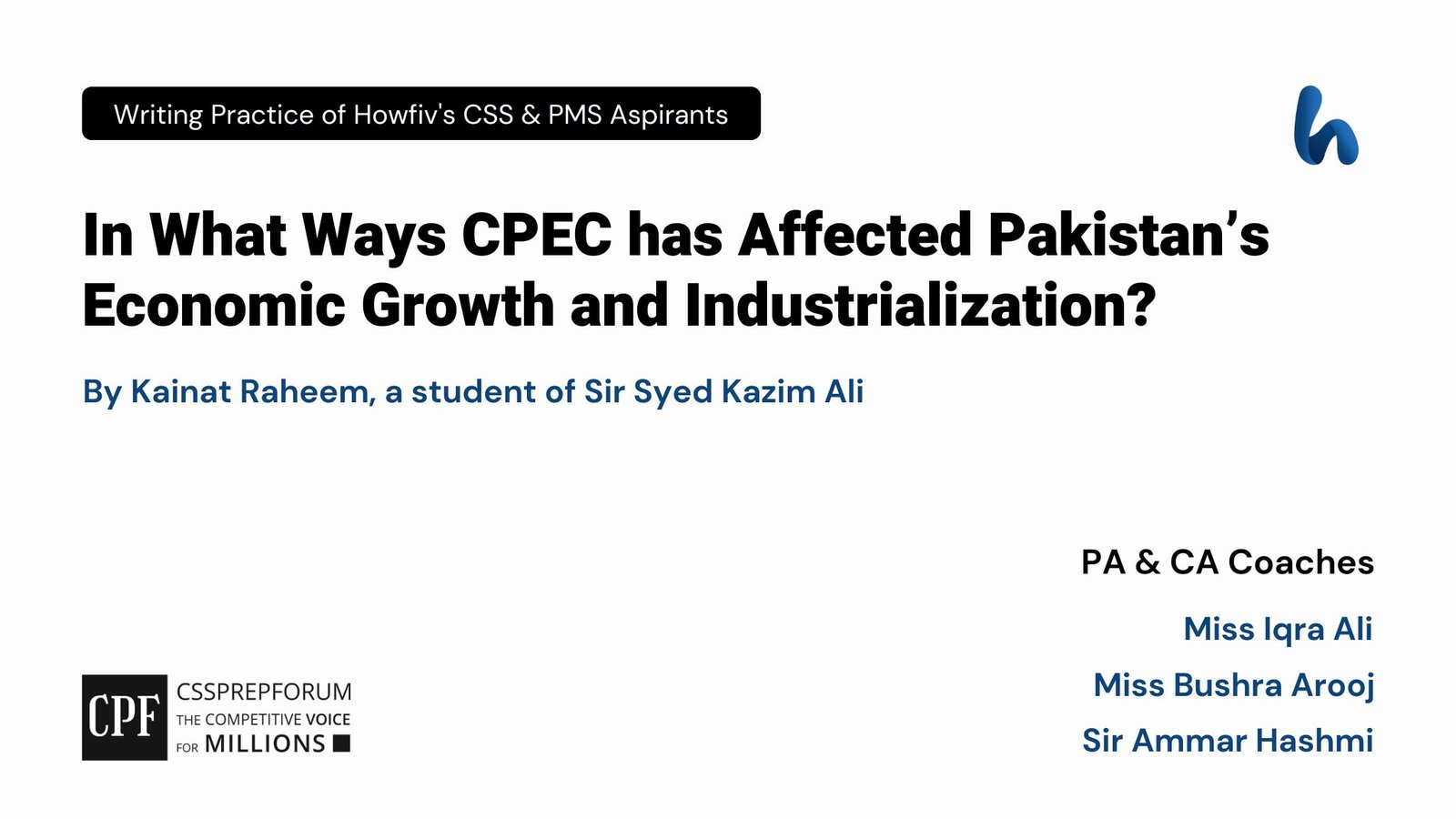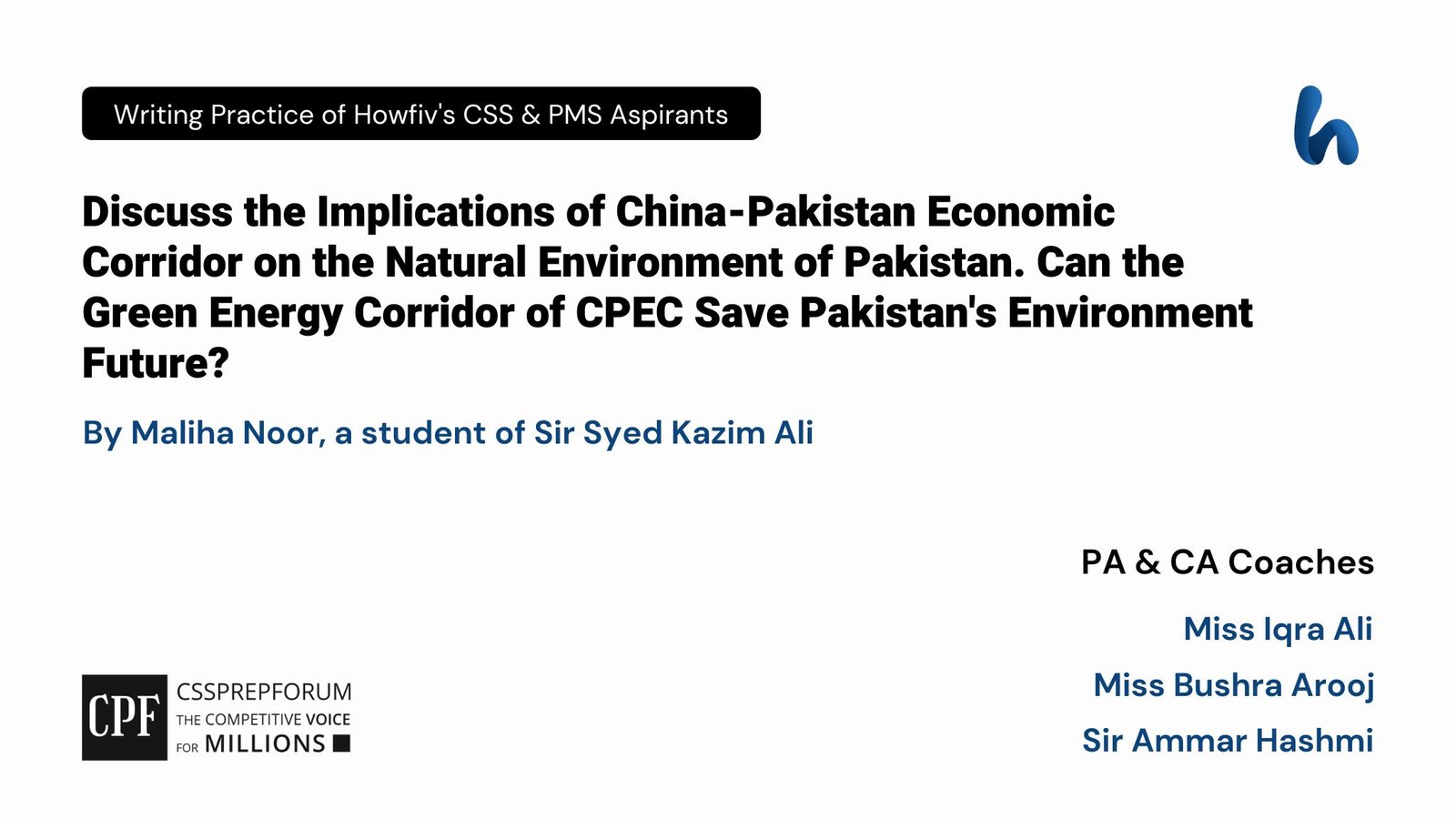CSS 2023 Special Solved Pakistan Affairs Past Papers | Options for Pakistan to Deal with Global Warming
The following question of CSS Pakistan Affairs 2023 Special is solved by Miss Iqra Ali, the best Pakistan Affairs Coach, on the guided pattern of Sir Syed Kazim Ali, which he taught to his students, scoring the highest marks in compulsory subjects for years. This solved past paper question is uploaded to help aspirants understand how to crack a topic or question, how to write relevantly, what coherence is, and how to include and connect ideas, opinions, and suggestions to score the maximum.

Question Breakdown
In this question, the examiner has asked you one leading thing what policy options should Pakistan exercise to effectively address its vulnerability to the phenomenon of Global Warming? So, first, you need to briefly introduce the main points of what you are about to write in your answer. Then, provide details in the main body of the answer with supporting policy cases or real-time examples of the countries which are proven successful in mitigating the effects of global warming by implementing their robust policies. Finally, end your answer with a critical analysis and conclusion. Remember, the following solved question provides a comprehensive answer covering all the main aspects. However, as far as the answer in the paper is concerned, limit yourself to 3 or 4 leading arguments against each part of the question.
Outline
1-Introduction
2-Understanding the Term Global warming and its Impacts on Pakistan
3-What Policy Options Should Pakistan Exercise to Effectively Address its Vulnerability to the Phenomenon of Global Warming?
3.1- For Climate Adaptation and Resilience
- ✓Enhancing Climate Adaptation by Localizing the Adaptation Plans
- ✓Increasing Climate Resilience by strengthening Disaster Risk Management
- ✓Developing the Climate Resilient Infrastructure
3.2- For the Management of Water and Agricultural Resources
- ✓Implementing Indus Basin Model Revised (IBMR) forPromoting the Sustainable use of Water Resources
- ✓Tailoring the Policy of Indus River Basin with the Living Indus Initiative
- ✓Promoting Climate Resilient crops
3.3- For Mitigation of the Effects of Global Warming
- ✓ Implementing Indus Basin Model Revised (IBMR) to Develop Energy Efficient Programs, such as Transition into Renewable Sources of Energy
- ✓Making and Implementing Afforestation and Reforestation Programs
- Promotion of Sustainable Agricultural Practices
4-Critical Analysis
5-Conclusion

Answer to the Question
Introduction
In the 21st century, the surging global warming is one of the gravest challenges confronting human beings, the environment, and the world economies around the globe. Unfortunately, the under-developing third-world countries are more prone to its calamitous impacts. Historically, Pakistan has remained grappling with the disastrous implications of global warming-induced climate change, such as droughts, land degradation, recurrent floods, melting of glaciers, heat waves, sea level rise, and increased frequency of cyclones. According to the United Nations Framework Convention on Climate Change (UNFCC), Pakistan, although only contributing 0.9% to global greenhouse gas (GHG) emissions, is one of the most vulnerable countries to the impacts of climate change. However, it has subjected the country to a greater risk of vulnerability, such as food insecurity, water insecurity, and loss of human lives due to climate-induced catastrophes. Moreover, it is high time to devise a pragmatic policy that can effectively address the country’s vulnerability to the effects of Global Warming. This policy could include climate adaptation and resilience, shifting to natural sources of energy, devising afforestation plans, managing water and agricultural sources, initiatives for the protection of biodiversity, etc. To conclude, it’s high time to formulate a realistic and tailored policy with climate goals to mitigate the adverse impacts of climate change. The following policy options may help the country to mitigate the impacts of global warming.
Understanding the term Global Warming and its impacts on Pakistan
Global warming is an extreme weather condition characterized by a gradual increase in the Earth’s average temperature. Pakistan is among the top 20 countries most affected by climate change. The country is highly vulnerable to the impacts of climate change because of its geographic location in South Asia. The irreversible effects of global warming have caused devastating natural disasters, which are an alarming threat to human lives around the globe. First, it causes the melting of glaciers, polar ice, and ice sheets, and even drought. According to a report,in many regions of Pakistan, the temperature exceeded 122°F (50°C), so Gilgit Baltistan and KP are the most vulnerable to the negative impacts of Global warming because of the presence of glaciers. Second, a rise in sea level due to heavier rains causes floods. In 2022, the country was hit hard by massive floods during monsoon season, which affected almost two-thirds of the country’s districts. Third, from pollution to overpopulation, 75 percent of climate change is caused by human activities. However, the nation appears to be a recipient of natural calamities despite being the least instigator of global warming, as Pakistan contributes considerably less than 1% of Global greenhouse gas emissions.
What Policy Options Should Pakistan Exercise to Effectively Address its Vulnerability to the Phenomenon of Global Warming?
3.1 For Climate Adaptation and Resilience
- ✓Enhancing Climate Adaptation by Localizing the Adaptation Plans
Particularly, the localization of adaptation plans is indispensable for targeting vulnerable communities. The government must take initiatives to localize climate adaptation plans by engaging local communities and indigenous groups in the planning process. The policy initiatives may include participatory decision-making and public consultations to help gather input from different groups. In addition, climate impact studies can help to tailor the policy to the local conditions. Other policy options may involve capacity building by training and supporting the private institutions, decentralizing the planning to collaborate with the local authorities, and incorporating local economic initiatives and educational campaigns.
- ✓Increasing Climate Resilience by strengthening Disaster Risk Management
In the same way, the country’s policy should also include strengthening risk management to adopt a realistic approach towards addressing the impacts of global warming. To empower the Disaster Risk Management (DRM) system, the government can introduce early warning systems, community engagements, and awareness programs. However, the institutional capacity can be increased by enhancing coordination and developing disaster management plans.
- ✓Developing the Climate Resilient Infrastructure
Furthermore, the government must take the initiative to assess risks and integrate climate data into the infrastructure development plan to develop climate-resilient infrastructure. It requires resilient designs and engineering, such as flood, wind, heat, and seismic-resilient structures. In addition, sustainable urban drainage systems (SUDS) may help to develop green infrastructure, manage natural water, and improve drainage networks.
3.2 For the Management of Water and Agricultural Resources
- ✓Implementing Indus Basin Model Revised (IBMR) for Promoting the Sustainable use of Water Resources
The Indus Basin Model Revised (IBMR)is a hydro-agro-economic optimization model aimed at raising agricultural investments across the areas of the Indus Basin. The government should implement IBMR in its true sense to ensure sustainable use of water and irrigation sources. It also helps to promote the sustainable use of groundwater and other water resources for irrigation. Thus, it has the potential to mitigate the potential risk of water and food insecurity due to climate change in the country.
- ✓Tailoring the Policy of the Indus River Basin with the Living Indus Initiative
The government policy should include collaboration with international initiatives such as the Living Indus Initiative to deal with the problem of wastage in water bodies. Other sustainable plans need implementation, such as the Indus Basin Model Revised and Sustainable Urban Drainage Systems (UDS). It can be done by constructing wetlands and rainwater harvesting systems, integrating green corridors, designing tree pits, and developing infiltration trenches, filter strips, detention basins, biofilters, swales, and soakaways.
- ✓Promoting Climate Resilient crops
The national policy must include the promotion of climate resilient corps to cope with food insecurity. It can happen by promoting climate-resilient corps, such as drought-tolerant crops (DT maize, sorghum, millets), flood-resilient corps (scuba rice, taro, water spinach), heat-resistant crops (coupes, report beans, amaranth), salt-tolerant crops (quinoa, barley, mangrove rice), disease-resistant crops (cassava, BT cotton and BT corn, rust-resistant wheat). In addition, crops that have shorter growth cycles should be promoted at the national level. Strategies may include the promotion of breeding programs, seed banks, education, and collaboration with international organizations.
3.3 For Mitigation of the Effects of Global Warming
- ✓ Implementing Indus Basin Model Revised (IBMR) to Develop Energy Efficient Programs, such as Transition into Renewable Sources of Energy
As discussed earlier, the implementation of the Indus Basin Management Revisit (IBMR) is indispensable for developing energy-efficient programs and sustainable agricultural practices. For example, the initiative of the Indus Basin Model Revised (IBMR) has the potential to address the issues of power generation and irrigation simultaneously. The government must devise a policy that can align with these programs, such as the implementation of the Indus Basin Model Revised (IBMR) in its true sense, as it also helps to develop Energy Efficient Programs, such as Transition into Renewable Sources of Energy.
- ✓Making and Implementing Afforestation and Reforestation Programs
Next, the government policy must include clear objectives such as mitigation goals, biodiversity conservation, and economic goals. The policy can include the promotion of sustainable practices, such as agroforestry, sustainable forest management, and climate-resilient species. The government must establish legal and regulatory frameworks, provide financial incentives, ensure sustainable funding, create enforcement mechanisms, integrate international frameworks, and create feedback mechanisms for implementation.
- ✓Promotion of sustainable agricultural Practices
Besides, the government can include policy programs, such as training programs for farmers, promotion of agro ecological practices, organic and regenerative agriculture, water-smart agriculture, mulching, soil health, technology and innovation, and national policies for regulation.

Critical Analysis
In a robust analysis, a policy that effectively addresses the implications of global warming and helps to adapt the vulnerable population is necessary for countries highly prone to the adverse effects of climate change due to their geographic proximity to the risk points. However, there are many glaring examples of countries that became champions of climate change due to their effective policies. For instance, Denmark became a global leader in renewable energy and climate diplomacy, Costa Rica in achieving sustainability, New Zealand due to its nature-based solutions, Norway due to electric cars adoption, and Finland in sustainable forestry. Moreover, it is high time to devise a national plan of action and effective policies that can help to mitigate the adverse effects of global warming.
Conclusion
To conclude, Pakistan has remained grappling with the disastrous implications of global warming-induced climate change. However, the nation appears to be a recipient of natural calamities despite being the least instigator of global warming, as Pakistan contributes considerably less than 1% of Global greenhouse gas emissions. Thus, a National Action Plan (NAP) and a pragmatic policy are needed of the hour at federal and provincial levels for building resilience to Global warming. However, the plan may include mitigation, adaptation, and capacity building to combat the hazardous impacts of Global warming.
CSS Special 2023 Solved Pakistan Affairs
CSS Solved Past Papers’ Essays
Looking for the last ten years of CSS and PMS Solved Essays and want to know how Sir Kazim’s students write and score the highest marks in the essays’ papers? Then, click on the CSS Solved Essays to start reading them.
CSS Solved Essays
CSS Solved General Science & Ability Past Papers
Want to read the last ten years’ General Science & Ability Solved Past Papers to learn how to attempt them and to score high? Let’s click on the link below to read them all freely. All past papers have been solved by Pakistan’s top CSS GSA coach having the highest score of their students.
General Science & Ability Solved Papers












